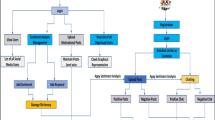Abstract
Online social networking has caused profound changes within the manner folks communicate and move. These changes might have an effect on sure traditional aspects of human behavior and cause medical specialty disorders. Mental disease is quickly turning into one in every of the foremost current public unfitness around the world. Social media networks, wherever clients will categorical their emotions, feelings, and thoughts, area unit a worthy supply of knowledge for analyzing mental state, and procedures supported machine intelligence area unit more and more used for this purpose. It is difficult to sight social network mental disorder (SNMDs) as a result of the mental factors thought of in existing diagnostic criteria (questionnaire) cannot be determined from online group action logs. To mechanically sight SNMDs cases of OSN clients, taking out these constraints to evaluate user’s online psychological states is extremely difficult. As an instance, the range of isolation with the impact of less inhibition of OSN clients do not seem to be simply discernible. Abnormal activity connected keywords area unit generated and hold on server. Each user activity (tweets, post, comments, etc.) information area unit hold on in information that may be accustomed analyze folie. This can facilitate to observe user activities in social network. Projected work detects sever style of SNMDs with a binary SVM classification approach.
Access this chapter
Tax calculation will be finalised at checkout
Purchases are for personal use only
Similar content being viewed by others
References
Bhattacharyya D, Kumari NMJ, Joshua ESN, Rao NT (2020) Advanced empirical studies on group governance of the novel corona virus, mers, sars and ebola: a systematic study. Int J Current Res Rev 12(18):35–41. https://doi.org/10.31782/IJCRR.2020.121828
Doppala BP, NagaMallik Raj S, Stephen Neal Joshua E, Thirupathi Rao N (2021) Automatic determination of harassment in social network using machine learning. https://doi.org/10.1007/978-981-16-1773-7_20, Retrieved from www.scopus.com
Eali SNJ, Bhattacharyya D, Nakka TR, Hong S (2022) A novel approach in bio-medical image segmentation for analyzing brain cancer images with U-NET semantic segmentation and TPLD models using SVM. Traitement Du Signal 39(2):419–430. https://doi.org/10.18280/ts.390203
Eali SNJ, Rao NT, Swathi K, Satyanarayana KV, Bhattacharyya D, Kim T (2018) Simulated studies on the performance of intelligent transportation system using vehicular networks. Int J Grid Distribut Comput 11(4):27–36. https://doi.org/10.14257/ijgdc.2018.11.4.03
Joshua ESN, Battacharyya D, Doppala BP, Chakkravarthy M (2022) Extensive statistical analysis on novel coronavirus: towards worldwide health using apache spark. https://doi.org/10.1007/978-3-030-72752-9_8. Retrieved from www.scopus.com
Joshua ESN, Bhattacharyya D, Chakkravarthy M (2021) Lung nodule semantic segmentation with bi-direction features using U-INET. J Med Pharm Allied Sci 10(5):3494–3499. https://doi.org/10.22270/jmpas.V10I5.1454
Joshua ESN, Bhattacharyya D, Chakkravarthy M, Kim H (2021) Lung cancer classification using squeeze and excitation convolutional neural networks with grad cam++ class activation function. Traitement Du Signal 38(4):1103–1112. https://doi.org/10.18280/ts.380421
Joshua ESN, Chakkravarthy M, Bhattacharyya D (2021_ Lung cancer detection using improvised grad-cam++ with 3D CNN class activation. https://doi.org/10.1007/978-981-16-1773-7_5, Retrieved from www.scopus.com
Bhattacharyya D, Doppala BP, Thirupathi Rao N (2020) Prediction and forecasting of persistent kidney problems using machine learning algorithms. Int J Current Res Rev 12(20):134–139. https://doi.org/10.31782/IJCRR.2020.122031
Neal Joshua ES, Bhattacharyya D, Chakkravarthy M, Byun Y (2021) 3D CNN with visual insights for early detection of lung cancer using gradient-weighted class activation. J Healthcare Eng. https://doi.org/10.1155/2021/6695518
Neal Joshua ES, Chakkravarthy M, Bhattacharyya D (2020) An extensive review on lung cancer detection using machine learning techniques: a systematic study. Revue d’Intelligence Artificielle 34(3):351–359. https://doi.org/10.18280/ria.340314
Author information
Authors and Affiliations
Corresponding author
Editor information
Editors and Affiliations
Rights and permissions
Copyright information
© 2023 The Author(s), under exclusive license to Springer Nature Singapore Pte Ltd.
About this paper
Cite this paper
Reddy, B.D., Joshua, E.S.N., Rao, N.T., Bhattacharyya, D. (2023). Mental Disorder Detection in Social Networks Using SVM Classification: An Improvised Approach. In: Ogudo, K.A., Saha, S.K., Bhattacharyya, D. (eds) Smart Technologies in Data Science and Communication. Lecture Notes in Networks and Systems, vol 558. Springer, Singapore. https://doi.org/10.1007/978-981-19-6880-8_25
Download citation
DOI: https://doi.org/10.1007/978-981-19-6880-8_25
Published:
Publisher Name: Springer, Singapore
Print ISBN: 978-981-19-6879-2
Online ISBN: 978-981-19-6880-8
eBook Packages: Intelligent Technologies and RoboticsIntelligent Technologies and Robotics (R0)




